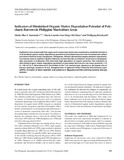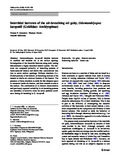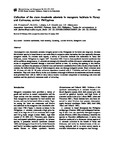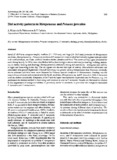Indicators of diminished organic matter degradation potential of polychaete burrows in Philippine mariculture areas
Share
Abstract
Sediments from underneath fish cages and in mesocosm tanks were examined to establish indicators of diminished organic matter degradation potential of polychaete burrows from increased mariculture activities in Bolinao-Anda, Pangasinan, Philippines. Results showed that simple sediment characteristics may be used as sediment quality indicators to describe the contribution of burrows to biodegradable processes in sediments with extremely high deposition of organic particles. The indicators of diminished organic matter degradation potential of polychaete burrows are low redox potential (-113 to -150 mV for F. Spionidae and F. Eunicidae) at the 1 cm surface layer, absence or decreased size of burrow openings, presence of H sub(2)S, disappearance of apparent Redox Potential Discontinuity Layer (aRPD), formation of black sediment, and presence of Beggiatoa (sulfide oxidizing bacteria) and gas bubbles.
Suggested Citation
Santander, S. M. S., San Diego-McGlone, M. L., & Reichardt, W. (2008). Indicators of diminished organic matter degradation potential of polychaete burrows in Philippine mariculture areas. The Philippine Agricultural Scientist , 91(3), 295-300. http://hdl.handle.net/10862/2085
Subject
Collections
- AQD Journal Articles [1249]
Related items
Showing items related by title, author, creator and subject.
-
Intertidal burrows of the air-breathing eel goby, Odontamblyopus lacepedii (Gobiidae: Amblyopinae)
Gonzales, Tomas T.; Masaya, Katoh; Ishimatsu, Atsushi (Ichthyological Society of Japan, 2008)Odontamblyopus lacepedii inhabits burrows in mudflats and breathes air at the surface opening. Investigations of the intertidal burrows using resin casting demonstrated a highly branched burrow system. The burrows are ... -
Collection of the clam Anodontia edentula in mangrove habitats in Panay and Guimaras, central Philippines
Primavera, Jurgenne; Lebata, M. J. H. L.; Gustilo, Lillian F.; Altamirano, Jon (Kluwer Academic Publishers, 2002)The mangrove clam Anodontia edentula is highly prized in the Philippines for its flavor and large size. Because this infaunal species is found down to one meter deep in mangrove areas, harvesting the clam reportedly damages ... -
Diel activity patterns in Metapenaeus and Penaeus juveniles
Primavera, Jurgenne; Lebata, J. (Springer Verlag, 1995)Small (5–10.9 mm carapace length), medium (11–15.9 mm), and large (16–20.9 mm) juveniles of Metapenaeus anchistus, Metapenaeus sp., Penaeus monodon and P. merguiensis were stocked individually in glass tanks provided with ...




